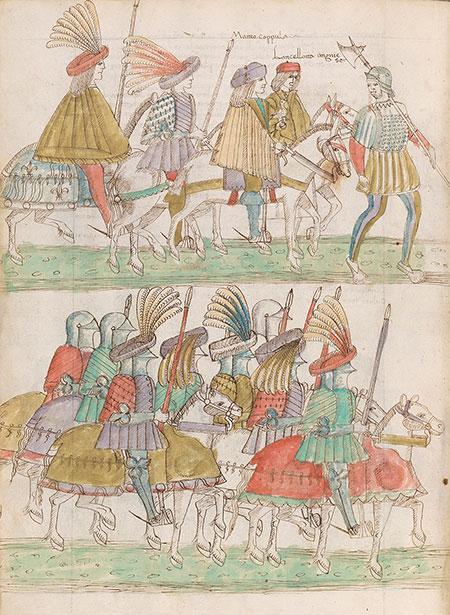
Ms. compendium of three late medieval chronicles, written and illustrated in Naples, Italy, shortly after ca. 1498.
Fasciculus temporum is a summary of world history compiled by the German monk Werner Rolevinck. The incomplete text and thirty pen and wash drawings of M.801 are based on the printed edition with woodcuts published by Erhard Ratdolt in Venice in 1481.
Cronaca di Partenope is an anonymous history of Naples from the early Middle Ages up to the beginning of the 15th century. In M.801, the Cronaca is followed by Bagni di Pozzuoli, an account of the medicinal Baths of Pozzuoli, as in many Cronaca manuscripts. The first printed edition of the Cronaca included an account of the Baths as well, in a brief translation of the Libellus de mirabilibus civitatis Putheolorum et locorum vicinorum. The text of M.801, fols. 52r-88r, was transcribed from this first printed edition, produced by Francesco del Tuppo in Naples between 1486 and 1490. The Morgan copy of the Cronaca di Partenope also includes additional excerpts relating to Naples from Giovanni Villani's Cronaca fiorentina.
Bagni di Pozzuoli is followed by the unique copy of an untitled continuation (called here Cronaca della Napoli aragonese) which describes events in Naples from 1423-1498. The author was the son of Francisco Ferraiolo, who witnessed the triumphal entry into Naples of King Alfonso I in 1443. Cronaca della Napoli aragonese is illustrated with about 120 pen and wash drawings of varying sizes. These drawings are of considerable interest for their detailed portrayals of contemporary personages and historical events, as well as Neapolitan life, costume and landscape.
Decoration: ca. 150 pen and ink drawings, tinted with colored wash, and numerous diagrams.
The illumination of M.801 is unfinished. Between fols. 128r and 145v, spaces were left for 53 drawings that were never executed.
